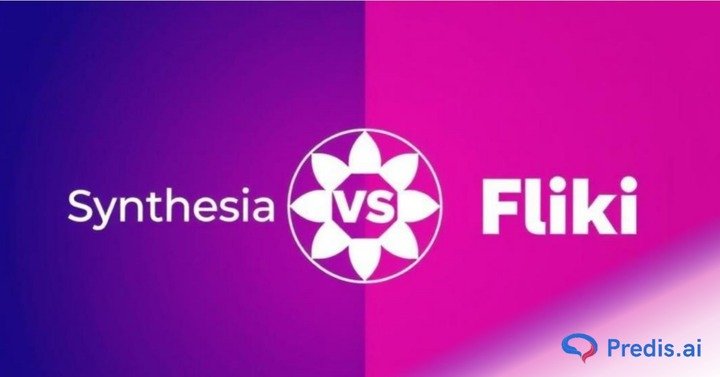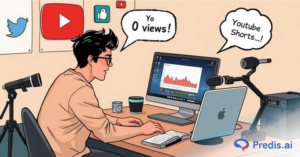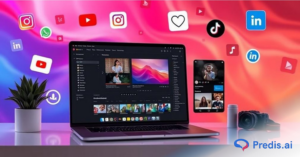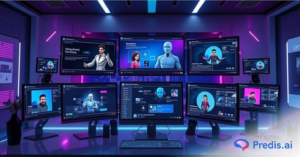AI video creation isn’t just a novelty anymore, it’s the new normal. In 2025, creators, marketers, educators, and businesses are ditching traditional video production for faster, smarter tools that turn text into polished videos in minutes. And two names keep popping up in that conversation: Synthesia vs Fliki.
So why does this comparison matter now more than ever? While both tools promise simplicity, scalability, and automation, they approach video creation in very different ways. Synthesia leans into hyper-realistic avatars and enterprise-grade polish. Fliki, on the other hand, offers unmatched voice options and quick, customizable editing for everyday content creators.
The rise of remote teams, global audiences, and content overload means that AI video tools are no longer just “nice to have.” They’re essential. If you’re wondering which platform best fits your 2025 workflow, goals, and budget, this breakdown of Synthesia vs. Fliki will help you make an informed decision with clarity.
What “Synthesia vs Fliki” is all about
Before we dive into the details, let’s get a clear snapshot of what Synthesia vs Fliki means.

Synthesia is built for scale. It’s known for its lifelike AI avatars, used by companies worldwide to create training videos, explainer content, and internal communications, without ever touching a camera. With access to over 230 avatars, support for 140+ languages, and seamless integrations with stock libraries like Shutterstock, Synthesia is a favorite for teams that need high-quality video fast, especially across global markets.
Fliki, in contrast, started as a text-to-speech platform and evolved into a powerful text-to-video tool. What sets Fliki apart is its library of over 2000 voice options, spanning 70+ languages and dialects, offering creators a ton of flexibility. It’s a go-to for content marketers, podcasters, YouTubers, and solo creators who want to turn blog posts or scripts into videos with minimal effort and with surprisingly natural voiceovers.
In the Synthesia vs Fliki debate, the question isn’t just which one is “better,” but which one better fits your specific use case, whether that’s creating multilingual training content or turning your tweets into short-form videos.
Synthesia vs Fliki: Pricing & Free Tiers
When it comes to choosing between Synthesia vs Fliki, pricing often becomes the dealbreaker, especially for solo creators or small teams working with tight budgets.
Synthesia’s free plan offers a limited but polished experience: you get to create a single 3-minute video per month using one of their stock avatars. It’s clean, professional, and watermark-free, but it’s also very restrictive. You’ll need to upgrade quickly if you want more flexibility or volume.
Fliki’s free tier gives you 5 monthly credits, which roughly translates to 5 minutes of video. It includes access to their full voice library and stock media, but videos come with a watermark, and you don’t get avatar access unless you’re on a paid plan. It’s great for testing the waters or producing quick internal drafts.
Now, the paid plans.
- Synthesia’s Starter plan begins at around $22/month (billed annually). It includes 10 video credits/month, access to over 90 avatars, 120+ languages, and basic branding options. For larger organizations, custom enterprise plans unlock team collaboration, API access, and dedicated support.
- Fliki’s Standard plan starts at $28/month, offering 180 minutes of video/month, commercial rights, HD downloads, and 850+ voices. Their Premium tier (around $88/month) adds voice cloning, AI avatars, and longer video limits.
So, in the Synthesia vs Fliki pricing battle:
- Synthesia gives you polished corporate video tools, but it gets expensive if you scale fast.
- Fliki is more generous with minutes and editing features, but you’ll pay extra if you want realistic avatars or voice cloning.
Synthesia vs Fliki: Avatars & Video Quality
In the Synthesia vs Fliki showdown, avatars are one of the biggest differentiators, and Synthesia takes the lead here without question.

Synthesia’s avatars are hyper-realistic and professionally produced, with over 230 stock options representing a diverse range of ages, ethnicities, and professional looks. Each avatar is modeled from real actors, with facial expressions, gestures, and lip-syncing that feel polished and natural. Pair that with Shutterstock integration, and you’ve got a platform built for slick, corporate-quality video at scale.
Fliki, on the other hand, offers a much more basic avatar system. While they’ve recently added avatar functionality, it’s not the core of their platform. The avatars feel more experimental and are secondary to the voice-first experience. This makes Fliki a better choice if you’re focused on turning scripts into voice-led videos, like explainers, audiograms, or repurposed blog content.
So, in terms of avatar realism and overall video polish, Synthesia is the clear winner. But in the context of Synthesia vs Fliki, it comes down to what your videos need:
- If face-to-camera presence and visual storytelling matter, go with Synthesia.
- If voices and speed take priority over realism, Fliki holds its own.
Synthesia vs Fliki: Voices & Language Support
When it comes to voices and language diversity, the Synthesia vs Fliki comparison gets interesting because both platforms excel, but in different ways.
Fliki pulls ahead in sheer variety. With 2,000+ AI voices across 70+ languages and dialects, it gives users an incredible range of tones, accents, and delivery styles to play with. Whether you’re producing a YouTube video, podcast snippet, or Instagram reel, Fliki’s voice engine offers everything from conversational to dramatic narration, making it ideal for creators who want to stand out or localize their content with nuance.
Synthesia, meanwhile, offers 120+ voices in over 140 languages, which covers more global territory than Fliki. While the voice library isn’t as massive, the quality is high, and the voices are tightly integrated with its avatars for smoother lip-sync and delivery. This makes Synthesia a strong choice for corporate training, multilingual marketing, or internal communications where clarity and professionalism matter more than variety.
So in the Synthesia vs Fliki voice and language match-up:
- Choose Fliki if voiceovers are the star of your content and you want the widest vocal palette.
- Go with Synthesia if you’re targeting a global audience and need clear, consistent narration synced to avatars in multiple languages.

Synthesia vs Fliki: Editing & Customization
In the Synthesia vs Fliki debate, editing flexibility can make or break your workflow, especially if you’re creating multiple videos at scale or want a platform that lets you fine-tune the final product without jumping into another tool.
Fliki shines in this department. It’s built for creators who want quick control over how their content looks and flows. With intuitive timeline editing, transition effects, text overlays, and a drag-and-drop interface, Fliki feels more like a lightweight video editor than just a text-to-video tool. That’s probably why it scores higher on user platforms like G2—8.8 for editing and UX, compared to Synthesia’s 8.0. It’s especially useful for short-form content, social videos, and repurposing blog posts or scripts into engaging visual stories.
Synthesia, on the other hand, takes a more structured approach. It offers professionally designed templates, slide-based video creation, and clean brand customization options (like fonts, colors, and logos). While you won’t get detailed timeline editing or granular control over transitions, you do get consistency and speed, perfect for training modules, product explainers, or company updates. Editing features are gradually improving, but they still lag behind what Fliki currently offers.
So, in terms of editing and customization, here’s the Synthesia vs Fliki takeaway:
- Fliki gives you more creative freedom and hands-on control—great for agile creators and marketers.
- Synthesia keeps things streamlined and polished—ideal for teams that value speed, consistency, and on-brand video output.
Synthesia vs Fliki: Pros & Cons (User Reviews)
To really understand the Synthesia vs Fliki decision, it helps to hear what actual users are saying, because flashy features don’t always tell the whole story. Based on user reviews and side-by-side comparisons, here’s a real-world breakdown of what works and what doesn’t.
Synthesia – Pros
- Lifelike avatars: This is where Synthesia truly shines. The avatars look professional, diverse, and convincing enough for corporate training, marketing videos, and client presentations.
- High-quality video output: The result feels polished and clean, perfect for teams that care about brand image.
- Enterprise-ready: With support for teams, branding kits, and multilingual voiceovers, Synthesia is well-equipped for business use.
Synthesia – Cons
- Editing limitations: You don’t get timeline-based editing or transition control. It’s more template-driven than flexible.
- Occasional robotic delivery: While the avatars are visually impressive, some users mention that expressions and tone can feel a bit flat or robotic, especially in longer videos or certain languages.
Fliki – Pros
- Natural-sounding voices: With 2,000+ options, Fliki delivers variety and nuance—great for storytelling, explainer videos, and voice-first content.
- Better editing tools: From transitions to on-screen text, Fliki offers more control and a smoother creative process.
- Small business–friendly: The pricing, voice variety, and ease of use make it a hit with freelancers, solopreneurs, and startups.
Fliki – Cons
- Basic avatar functionality: While avatars exist, they’re limited in realism and motion compared to Synthesia.
- Simpler visual quality: Transitions and scene design are functional but not as polished—better suited for fast content than cinematic output.
So, in the Synthesia vs Fliki pros and cons round, it’s clear:
- Synthesia wins on polish, professionalism, and visual presence.
- Fliki leads on flexibility, voice quality, and ease of editing.

Final Verdict: Synthesia vs Fliki in 2025
Here’s the thing—Synthesia vs Fliki isn’t about which tool is objectively “better.” It’s about which one fits the way you work.
If you’re creating training videos, internal communications, or polished brand content where the presenter needs to look professional and speak multiple languages, Synthesia is the stronger choice. Its realistic avatars, clean templates, and corporate-ready features make it ideal for teams that need to scale high-quality video fast, without a steep learning curve.
But if your priority is flexibility, speed, and voice-driven storytelling, Fliki is tough to beat. With a massive voice library, easy editing tools, and affordable pricing, it’s perfect for creators, marketers, and small businesses pumping out content for YouTube, social media, or podcasts.
In short:
- Go with Synthesia for visuals, professionalism, and multilingual avatar videos.
- Choose Fliki for voice-first content, hands-on editing, and a friendlier budget.
The Synthesia vs Fliki question isn’t about who wins. It’s about what you need to create—so match the tool to your workflow, not the other way around.
You can also check out this blog on Sora vs Veo!















